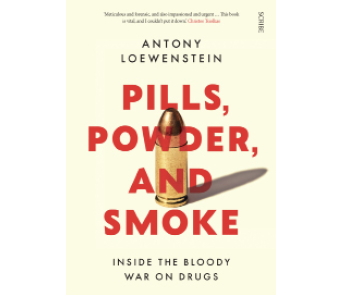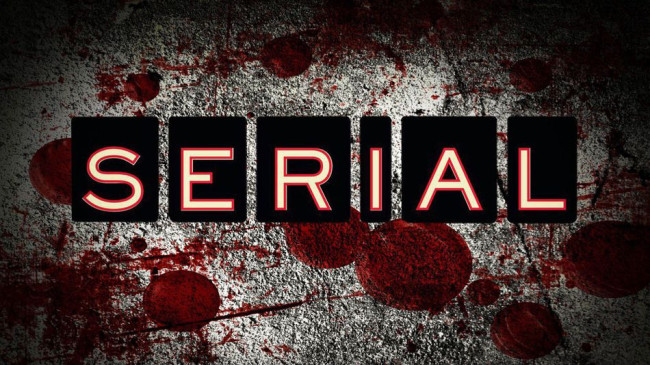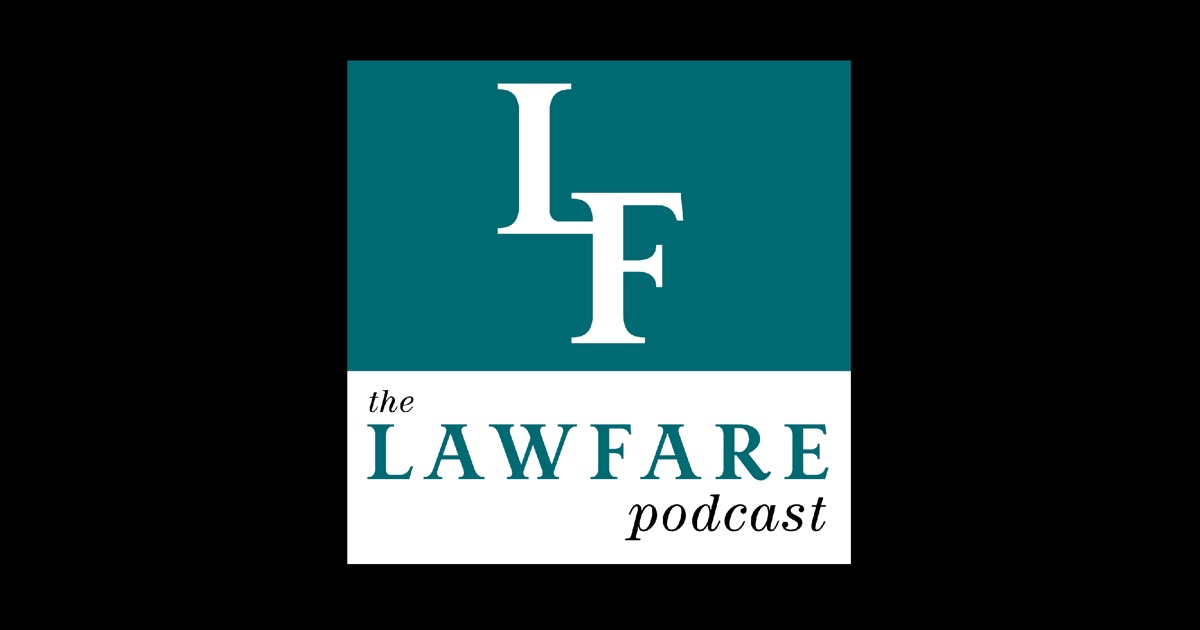Reviews

Pills, Powder and Smoke:
Inside the Bloody War on Drugs
Antony Lowenstein
Melbourne 2019
‘Ain't no structure, no peace, we've lost our order
Leaving me with anxiety, fucking up my sobriety’
PTSD, G Herbo, Warner Chappell Music
During the COVID-19 restrictions on school attendance, parental reliance on the sedative effects of alcohol to relieve from the stress of home-schooling has become an internet meme and sketch-comedy staple. A survey by the Australian National University found that almost 20 per cent of people drank more alcohol during COVID-19 restrictions than usual.1 Psychological distress was most likely the cause, particularly for males. Males living in advantaged areas were more likely to report an increase compared to men in less advantaged areas.
To say that psychoactive substances are widely and commonly used is banal. They are presently and historically ubiquitous, whether legally approved, regulated and subject to government excise, or prohibited and traded on the black market, with distribution controlled by organised criminal enterprises.
Official sanction of amphetamine use during World War Two is well known. For example, Benzedrine tablets manufactured by Smith, Kline & French (SKF) given to RAF pilots as part of their survival packs. From 1932 until the 1970s amphetamines were commonly available in the form of Benzedrine inhalers.2 After the war, SKF diversified its amphetamine business to include weight loss and anti-depressant drugs.3 In Australia, various psychostimulant medications are prescribed to treat ADHD.4 Widespread addiction to prescription opioids such as Vicodin and fentanyl has recently become a major public health issue.5
The health risks associated with illicit drug use are not a valid reason for criminalisation. Alcohol consumption is legal despite there always being some risk to the drinker’s health and social wellbeing.6 Similarly, the use and misuse of illicit drugs are matters better dealt with under health and welfare policies than under the criminal justice system.
In Pills, Powder and Smoke, Lowenstein adds the voices of the marginalised to the evidence showing that prohibitionist drug laws and policies cause greater harm to individuals and communities than any purported increase in the social good, as well as continuing to fall far short of achieving their objectives. The narrative spine of the book is provided by the stories of people negatively impacted by the ‘war on drugs’ in Honduras, Guinea-Bissau, Philippines, United States, Britain and Australia.
In the chapters on Honduras, Guinea-Bissau and the Philippines, the war on drugs is seen to increase and entrench the overall level of violence, as well as the corruption of politicians and government officials. Countries such as Guinea-Bissau and Honduras are transit points along international trade routes used by cartels to distribute illicit drugs targeted by the United States Drug Enforcement Agency. A recent article in the Australian Financial Review discusses the downturn in the business of drug cartels caused by border closures due to COVID-19, illustrating two key points:
- the lockdown has succeeded in causing major disruption to the international supply chain relied on by cartels to distribute illicit drugs, where decades and billions of dollars spent on a militarised 'war on drugs' has failed;
- analysts predict that with the opening up of borders and resumption of international trade, the illicit drug trade will also resume, and that the bigger cartels with the resources to survive will likely benefit at the expense of the smaller ones, like businesses in other areas of the economy.7
In the chapters on the USA, Britain and Australia, Lowenstein’s focus is largely on the trauma that underlies personal drug use and dependency. He also looks at the disproportionately negative impact of the criminal justice system on drug users, notably black communities suffering intergenerational trauma and structural racism whose members are overrepresented in prison populations.
Lowenstein eschews an objective journalistic stance, advocating in favour of the decriminalisation of personal drug use and possession, combined with social and health services directed at harm reduction. Similar views can be heard more frequently being expressed by citizens across the social spectrum and notably by law-makers in Canada, Portugal, Uruguay, several States in the US, and the Australian Capital Territory.
In 2018, a recommendation was made by the Victorian Parliamentary Inquiry into Drug Law Reform to implement pill-testing. It was rejected by the government, making clear its stance against decriminalisation of the use and possession of illicit drugs.
Also in 2018, after three years of hearings the Commonwealth Parliamentary Inquiry into ‘ice’ concluded, 'the current approach to addressing methamphetamine use in Australia was not working, and that the focus should shift from methamphetamine as a law enforcement problem to a health issue within an environment where treatment and support are readily available and without stigmatisation.'8 To date there has been no response by the government.
At the end of 2019, the New South Wales Coronial Inquest into Music Festival Deaths referred to the 'wealth of evidence that demonstrates the benefits of alternatives to arrest for use and possession offences' (Inquest). Deputy State Coroner, Magistrate Harriet Grahame concluded:
'There is a need to closely examine decriminalising the personal use of drugs as a mechanism to reduce harm. The evidence revealed the many contradictions in our current limited approach.'9
She commented on the contradiction between harm reduction and criminalisation, illustrated by the police discretion to issue a Drug Criminal Infringement Notice (CIN) at music festivals to divert young people from the criminal justice system, while at the same time subjecting large numbers of young people to inspection by dogs, strip searches and questioning for possible criminal transgression. The recommendations, based on an impartial and careful consideration of the evidence, included trialling medically supervised substance testing at music festivals in New South Wales.
On 27 February 2020, the New South Wales government released the Final Report of the Special Commission of Inquiry into the Drug ‘Ice’ (Report). The original terms of reference were expanded to encompass amphetamine-type stimulants such as MDMA. After two years of hearings and receiving submissions, the Inquiry made one hundred and nine recommendations. Five were rejected by the government out-of-hand. In particular, the recommendation was rejected to establish a state-wide clinically supervised substance testing, education and information service, and trial an onsite substance testing service at a music festival10. That was despite the Inquiry finding that, 'there is strong and compelling evidence to support substance testing as an effective harm reduction measure'.11 The government’s response to the remaining recommendations is due at the end of the year.
The Report recommends decriminalising the possession of prohibited drugs for personal use.12 That is consistent with submissions made by the NSW Bar Association to the Inquiry.13 It is founded on, 'extensive evidence that criminalisation of simple possession is not effective to address the harms caused by drugs and itself causes disproportionate harm to people who use drugs'’.14 A 'key principle' that emerged from the evidence was that amphetamine use requires a compassionate response consistent with human rights approaches, rather than a punitive response that compounds the harms of use.15
If compassion is to play a role in reforming the criminal law it cannot grow out of statistics and data but from consideration of the life stories of drug users such as Lowenstein’s interviewees and others like them which reveals the trauma that often underlies drug use, especially dependency. Consideration can only be given to a relatively small number of personal stories, bearing in mind that in 2017-18 there were 72,381 arrests in Australia for cannabis related offences alone.16 Of these, 92% were user-type offences and 8% were supply-type offences.17
In the chapter on Australia, Lowenstein introduces war veteran, Mick Harding. In 2012 he was medically discharged from the army following his return from deployment in Afghanistan. He was diagnosed as suffering post-traumatic stress disorder (PTSD), conversion disorder and major depression. The anti-psychotic and anti-depressant drugs he was prescribed increased his distress, culminating in homicidal and suicidal ideations. In an interview with the ABC he said it was ‘bizarre’ that these drugs are prescribed to treat people suffering suicidal thoughts from their experience of horrific events.18 Cannabis helped him manage his condition and function. He founded the group Weeded Warriors, supporting veterans in similar situations.
Despite the Federal Government legalising medicinal cannabis, regulatory barriers and conflicting state and federal laws have made it notoriously difficult to obtain a prescription and the legal supply of the product remains scarce. By contrast, in Canada recreational cannabis use has been legalised and veterans receive a government rebate for the purchase of up to three grams of cannabis per day for medicinal purposes including for the treatment of PTSD.19
The life stories of Lowenstein’s interviewees as well as testimony given at the Inquiry and Inquest, demonstrate the disproportionate harm that criminalisation may cause. The NSW Bar Association’s submission to the Inquiry recognised this in stating:
'Importantly, there are considerable harms associated with the criminalisation of personal drug use. The legacy of involvement in the criminal justice system can be far-reaching and long-lasting. It can affect a person’s ability to obtain and maintain employment, housing and education. Those who are incarcerated are exposed to more serious offenders. Incarceration substantially increases the risk of mortality. The criminalisation of personal drug use affects personal wellbeing and relationships. Social stigma and the activities of law enforcement can also undermine the implementation of harm reduction strategies.'
Finding the compassion to support decriminalisation of personal drug use comes more easily when it is a friend or loved-one who suffers the added trauma of criminal law enforcement and the intervention of the criminal justice system. Maybe it is your child who is subjected to the trauma of a police strip search at a music festival. The author of the present review can speak of a lifelong friend, ‘M’, who was arrested for growing cannabis plants in his garage for personal consumption. A neighbour informed the local police who investigated, setting up twenty four-hour street surveillance over a two-week period.
It was no surprise to the present author to learn that M was using cannabis as well as alcohol to self-medicate, after witnessing the following: M’s mother racing to get seven children into bed in the time between their father’s car pulling into the driveway and the back-door slamming shut, after he came home from the club; M’s father bellowing in the hallway, come and take your punishment like a man; M dragged from under the covers; the leather belt raised; M cowering on the floor; struggling to decipher the misdemeanour he is being summarily punished for, declared in slurred speech; buckle-end turned on upraised arms; his mother’s pleas to stop, unheeded; so too his sisters’ cries for mercy. M has since told me that the day his father broke his nose was the day his world was shattered. A few days off school for the swelling to go down. A backyard cricket accident. Given that experience…
A supply charge was laid against M and belatedly dropped. The visitors making small cash payments were reimbursing M for fixing their cars and paying a small reward, mostly members of his extended family. His irregular hours on weekends were because his job required him to be on-call. M pleaded guilty to possession. He received a section 10 order and good behaviour bond. In addition to experiencing the trauma of the police raiding his home, arresting him in front of family and neighbours, and the cost and stress of preparing to defend the supply charge, he faced the real possibility of a recorded conviction, forever stigmatising him as a criminal, damaging his prospects of future and better employment. Incarceration would have caused irreparable harm to every aspect of M’s life and that of his wife and child.
Lowenstein interviews former Federal Police Commissioner, Mick Palmer. His longstanding advocacy for decriminalisation is based on pragmatism, the ‘abject failure’ of prohibition to reduce supply and demand, no evidence of different levels of drug use between countries tough on drugs and those that are more lenient, and the belief that most people who use illicit drugs do so socially, at low levels, and like ‘M’ hold down decent jobs and don’t commit other crimes. He bemoans a lack of law reform, blaming media-induced hysteria. Crucially he observes, ‘We haven’t been very successful in personalising much of this’.
That negative media hysteria is counterbalanced by the growing anecdotal evidence of people benefitting from illicit drugs when prescribed pharmaceuticals have either failed to relieve or worsened their condition: children with epilepsy relieved from constant seizures by cannabis; PTSD sufferers recovering through LSD-psychotherapy treatment; cannabis helping cancer patients regain their appetite; chronic pain sufferers functioning again through cannabis use.
Patient information provided by the Therapeutic Goods Administration recognises there has been a lack of clinical trials for medicinal cannabis, but goes onto state that to date: the evidence is strongest for supporting the use of medicinal cannabis in the treatment of certain childhood epilepsies; cannabinoids may be effective for symptoms of pain and/or spasticity and may have a positive effect on sleep and bladder symptoms of MS sufferers; there is some evidence that cannabinoids can reduce chronic pain.-1
Lowenstein’s book is to be commended for illuminating how compassion is key to reforming drug law and policy, rather than providing hard data by which to measure the ineffectiveness of maintaining a prohibitionist and punitive approach. Indeed, such data is notably lacking in places and Lowenstein’s language occasionally veers into hyperbole and unsubstantiated generalisation. Readers interested in a thorough review of the evidence supporting decriminalisation are best advised to seek it elsewhere, for example, by reading the Report.
Sean O’Brien
1 Nicholas Biddle, Ben Edwards, Matthew Gray, Kate Sollis, ‘Alcohol consumption during the COVID-19 period: May 2020’, Centre For Social Research and Methods, Australian National University, https://csrm.cass.anu.edu.au/sites/default/files/docs/2020/6/Alcohol_consumption_during_the_COVID-19_period.pdf
2 Erin Blakemore, ‘A Speedy History of America’s Addiction to Amphetamine’, Smithsonian Magazine, 17/10/2017, https://www.smithsonianmag.com/history/speedy-history-americas-addiction-amphetamine-180966989/
3 Erin Blakemore, ‘A Speedy History of America’s Addiction to Amphetamine’, above.
4 ADHD – Frequently asked questions, NSW Health, https://www.health.nsw.gov.au/pharmaceutical/patients/Pages/faq-adhd-consumers.aspx#:~:text=In%20Australia%2C%20the%20psychostimulant%20medications,LA%C2%AE%2C%20Concerta%C2%AE
5 Erin Blakemore, ‘A Speedy History of America’s Addiction to Amphetamine’, above.
6 National Health and Medical Research Council, ‘Australian Guidelines to Reduce Health Risks from Drinking Alcohol’, 2009, 20.
7 Anthony Faoila and Lucien Chauvin, ‘Coca cash crop collapse leaves cartels reeling’, Australian Financial Review, 12 June 2020, 8R.
8 Commonwealth Parliamentary Joint Committee on Law Enforcement, Inquiry into crystal methamphetamine (ice) (Final Report, March 2018), 158.
9 Inquest into the deaths of six patrons of NSW music festivals, Hoang Nathan Tran, Diana Nguyen, Joseph Pham, Callum Brosnan, Joshua Tam and Alexandra Ross-King, Findings of Deputy State Coroner Grahame, 8 November 2019, [541]-[542].
10 Recommendation 53.
11 Report Vol 1(a), paragraph 122.
12 Recommendation 11.
13 NSW Bar Association Submission dated 7 September 2019, stated: 'It is the position of the Association that consideration should be given to decriminalisation of personal acquisition, possession and use of illicit drugs, with increased focus on treatment and harm reduction measures.'
14 Report Volume 1(a), paragraph 40.
15 Report Volume 1(a), paragraph 9.
16 Australian Crime Commission (2019), Illicit Drug Data Report 2017-18.
17 As above.
18 Triple J, The Hack, 14 September 2017, https://www.abc.net.au/triplej/programs/hack/smoking-cannabis-to-treat-ptsd-weed-veterans/8945080
19 Veterans Affairs Canada, Cannabis For Medicinal Purposes, https://www.veterans.gc.ca/eng/about-vac/research/research-directorate/publications/reports/cmp2018
-1 Australian Government, Department of Health, Therapeutic Goods Administration, ‘Medicinal cannabis products: Patient information’, https://www.tga.gov.au/community-qa/medicinal-cannabis-products-patient-information
EASTER in the time of CORONA
Tracing Noli Me Tangere Images –
a moment of pause and reflection


The 'Noli Me Tangere' scene is one of the best known in Christian paintings and iconography. It relates an aspect of the Easter story. Easter this year was a non-event and the order of the day was to stay away from people, to stay at home and not to gather or to socialise. The theme came to mind recently as the Coronavirus Pandemic gripped the world. It provides a pause for us to consider our place in the world. The Noli Me Tangere paintings are a perfect way to do that – the paintings depict a moment of pause and reflection. Easter and social distancing had curiously coincided providing another moment to pause and to reflect. This famous image is not just of an episode taken from the Bible with some religious connotations. It is an interesting and long-running theme of the finest painters throughout the Ages. It is a moment to reflect upon in these uncertain and strange times. Let us take a moment to think outside of ourselves. This article considers the depiction of some Noli Me Tangere images, their nature and how the image has evolved over time.
Whatever the medium, the much-replicated image by artists over the centuries of the Noli Me Tangere images marks the moment at dawn on the first Easter Sunday when Mary Magdalene attends the tomb to anoint the body of Christ according to tradition. The body is not there, instead a man suddenly appears whom she takes to be a gardener. The moment unfolds with this brief exchange:
Christ says: ‘Woman, why weepest thou? Whom seekest thou?’
Christ continues: ‘Mary’ […]
Mary knows immediately that it is Christ and she reaches for Him.
Mary says: ‘Master!’
Christ says: ‘Noli me tangere’.
The line Noli Me Tangere translates from the Latin 'don’t touch me' or 'touch me not; [for I am not yet ascended to my Father].' The imperative is all pervasive.
The message intended is that Christ may take the form of a man (at least visually), but His risen body is not of this world. He is the unascended Christ, hence the imperative not to touch.
Noli Me Tangere is sometimes translated as ‘Cling to me not’; it is an imperative to stay away or don’t come near. Some translators of that part of the gospel according to John translate it thusly. It is a loaded phrase especially with the world in the grips of pestilence. In fact, John is the only gospel to mention this magical moment – the meeting in the garden near the tomb of Christ and Mary Magdalene on the first Easter Sunday. No other writers recall this beautiful moment in time. It is curiously appropriate in these times of social distancing where observations are to be made from afar. It is also a cherished moment in Art. It is a moment in the interstices of time – somewhat hidden but always there, tucked away in the Johannine writings in Chapter 20, verses 14-17. It became a leitmotif in Art History. But why is the scene taking place in a park or a garden of some description? Where is it exactly? Is it a potager garden, why does it seem like someone is tending a vegetable patch? Is it the typical landscape of the time in the Holy Land?
.png)
Titian painted a most famous interpretation of ‘Noli Me Tangere’ which was displayed in the National Gallery in London (c.1514). The folds of linen drape like a luxurious shroud on Christ, the robes hang elegantly from Christ’s body and Mary Magdalene extends an arm as if to touch Him – to test that the image was not a dream. It is perhaps the most beautifully painted version. Mary Magdalene responds as humanly as possible. Her instinct is to touch to believe what is happening. It’s like the doubting Thomas moment captured by Caravaggio in his image 'The Incredulity of Saint Thomas' dating from the 17th century. Caravaggio was the equivalent of a Hollywood star in the constellation of painters of his time and the level of their fame or infamy. St Thomas seems to look intently at the wound in Christ’s side and seems to want to touch it with a hand to make sure it is his Master. Here Mary Magdalene’s wonderment gives rise to the doubt which will not be satisfied by the mere visage of the apparently risen Christ. It was a significant moment – she reached out as if touch would confirm it. Seeing is not believing – however, touching might be the ultimate test.
Paintings like the various versions of Noli Me Tangere were commissioned on church walls throughout Europe so that that the illiterate population (which was significant) could know the stories by looking at the images on the church walls. This became the artist’s challenge – to capture the moment. It was a question of skill and imagination to capture the moment for an illiterate person.
.jpg)
In Nicolas Poussin’s ‘Noli Me Tangere’ (1653), the most famous of these paintings, Christ stands in a vegetable garden (seemingly). He is foot to a spade, literally. Vegetation is all around, the flowers are old world herbs. A millefiori carpet of wildflowers forms the background. Christ immaculate, is dressed in an allotment smock, feet in sandals and He appears to be turning the earth. Equally, in Abraham Janssens’ depiction (c.1620), Christ is standing among pumpkins, cauliflowers; for all intents and purposes he is in a potager garden. Mary Magdalene kneels in what looks to be an artichoke bed.
So too, Fra Angelico’s fresco in San Marco in Florence (c.1438–50), is where we see Christ raising a tool on his shoulder standing in a garden of herbs. The shining white (reminiscent of the Roman candidatus) robes make it somewhat incredible to the eyes. A vision splendid. They cannot possibly be the robes of a serious gardener. Those types dress in overalls and sack cloths and are never seen in the shining white finery of a nobleman. It is the sublime to the ridiculous.
Artists who choose to paint the scene of Noli Me Tangere are subtle in their craft and the finesse of the image created is evident. It is the most painterly of the biblical images. The artists’ communication or message is often playful and meaningful. The moment captured in these paintings is the pause between the pain of the Passion (Good Friday) and the triumph of the Resurrection (New Life of Easter Sunday). Two extremes of experience are there, the pain and the gore (crucifixion) to the shining triumphant vision splendid in a peaceful garden (the Resurrection). We can imagine the elation from the horrible road to Calvary depicted in so many images of the Stations of the Cross. However, in the Noli me Tangere scene, a woman, Mary Magdalene takes centre stage and it is a prescient and thoughtful moment – a gentle and genteel pause in time. It is a tranquil moment. It is Mary Magdalene’s experience and what she sees, knows and touches. Noli Me Tangere scenes were popularly appearing in the prayer books printed in the Netherlands between the years 1100 and 1200.
Artists in those parts of the world were famous for their depictions of stormy, leaden skies, sallow, pale and forlorn faces drained of joy and life. Noli Me Tangere images are consistently serene and zen-like. There is a quiet joy and life in that moment depicted in the images.
.jpg)
By 1300 the Noli Me Tangere image was a trend in painting, much painted. Duccio in his ‘Maestà’ altar in the Siena Cathedral (c1308–11) depicted it, and shortly, before that the painter Giotto in the Scrovegni Chapel at Padua Italy (1303–05). Those artists chose to depict the Noli Me Tangere. On each rendering it is a beautiful image of Christian iconography. Giotto melds together two images: that of the lazy soldiers napping to the left and Christ with kneeling Mary Magdalene on the right. Giotto’s Christ is a powerful image – Christ is fending off Mary Magdalene and gestures for her to go away. It says more than don’t touch him, such that Christ is pushed up against the gesso frame to show him escaping touch. However, this is actually an old Giotto painting device. It is a trick of the eye. Giotto was a very 'painterly' painter – it is all in the technique and placement of his characters. Giotto’s characters are always exiting stage left or marching on stage right – the traditional entry and exit points on the dramatic stage. Duccio’s Christ is a statuesque figure – standing sentinel-like, the picture of calm. Duccio’s Christ keeps Mary Magdalene at bay with a zen-like wave, as if to quell any noise or to dismiss her. It is a hush, hush moment in a garden or an Eden-like landscape. It looks solemn. It is a carpet of flowers or a herbaceous border in the foreground. It looks like it is a deserted place and an arid landscape.
.jpg)
However, in Albrecht Dürer’s early woodcut (1511), Christ is depicted with the crown of thorns, applied with brute force in the days previous, except it has become like a cloth tied on his head – resembling a handkerchief hat. There is something makeshift about it. Dürer’s Christ takes a spade on one shoulder, as if to commence his day at work. He looks like he just came out from the potting shed, not a tomb. However, the stigmata on Christ’s hands and feet relate to the horrors of the previous days. Mary Magdalene is taken aback by the shock of seeing Him.
In Chichester Cathedral in the UK, there is a painting dating from 1961 in this fine tradition by Graham Sutherland (1903–1980). Christ wears an actual sun hat, ascends a staircase above a courtyard garden. It is a modern interpretation but the full expression of the subtleties made in the past are shown. It is a fleeting, esprit d’escalier moment for Mary. She raises her arm towards Christ as He ascends the stairs but He is already on the way (literally a Stairway to Heaven). It is still an elegant image infused with traditional meaning.
).jpg)
Finally, let us spare a thought this Easter, with the world in turmoil and think of Mary Magdalene, of her shock and her being transfixed as she recognises the face under the brim of the hat on Easter Day. The surrounding scene is of a vegetable garden and there is a warning to stay at distance. 'Noli Me Tangere' is a magical image of Easter that recurs throughout the Ages. It goes beyond any religious significance. It means much more than we would think, especially in the light of the strange times in which we currently live. It is, one might say, one of the eternal images which has come down through the Ages and which informs our present lives – when, literally, life imitates art.
Kevin Tang
8 Wentworth Chambers
Noli Me Tangere by Sutherland (1961)

The world of legal podcasts: an introduction
Just as broadcast television has to large degree given way to streaming and catch up services, allowing us to watch our favourite programs when and where it suits us, podcasts have given us the same ability to listen to content that used to be available only on the radio ('the wireless') at times of our choosing, and via our own phones or other devices.

But podcasts have gone further than just being radio programs available on demand. Serial, the podcast that became famous for 'breaking the internet' and which introduced many people to the genre for the first time, was never a radio program. In 2014, the US public radio program, This American Life, which has been airing in the US and other countries, including on Radio National in Australia, for many years, launched an independent 12 part series that was available only via podcasting. This was Serial season one1 and it was the first podcast to go, effectively, viral. The New York Times described it as 'podcasting’s first breakout hit': there were five million downloads within the first three months and estimates are that it was downloaded over 175 million times by 2017.
Given the relative novelty of the format to the public radio audience, Ira Glass, host of This American Life (itself a very successful podcast), posted a helpful video2 where he enlisted the aid of his friend Mary, who described herself as being on the 'dark side of 85', to show people unfamiliar with the genre how to listen to a podcast.

So why was Serial (season 1: there have been other seasons since) so popular? For starters, it was an extraordinarily compelling 'true crime' story, brilliantly executed. Made and presented by Sarah Koenig, it focussed on the murder conviction in 1999 of Adnan Syed, a young man (effectively, a school boy) for the brutal killing of Hae Min Lee, his former girlfriend and class mate. In addition to the questions raised about his guilt or innocence and whether all the relevant evidence had been before the Court and properly considered, there were a number of other legal issues, including about the quality of his representation by counsel. Listeners around the world posted theories on the internet about who was the 'real' killer and conducted their own experiments about things such as the timeline of events, even turning up at places mentioned in the podcast3 or arriving unannounced at the homes of some of the people discussed in it. And Phillip Street was certainly not immune to those theories and discussions, though mercifully too far away for its local enthusiasts to make nuisances of themselves on location.

HBO made a documentary series after the podcast4 which aired on SBS in 2019, and there was a revival of interest in the case from lawyers, as well as a series of renewed court applications said to result from some of the revelations in the series. The producer/narrator Sarah Koenig signed off in March 2019.5 While she indicated that she was done with reporting Adnan Syed’s case, she did advise listeners that Season 3 of Serial was also law related for those interested in what goes on in courtrooms. For that season, she spent a year recording in a Cleveland court from which she produced a series that Slate described as a 'morally complicated look at the [US’s] broken criminal justice system', which engages in a 'discomfiting dance between pragmatic calculus vs. receding principles,'6 revealing the overwhelming reliance of the system on plea bargaining, something certainly not limited to the United States.

Another outstanding criminal justice related podcast from the US is Emily Bazelon’s Charged,7 a 'true punishment' story which focuses on the increasing power of prosecutors (at the expense of judges) in the US criminal justice system. Another podcast which, like Serial, delved into a real case is In the Dark, season 2 of which concerned Curtis Flowers who had been tried six times for the same crime.8 That series ended with the case going to the US Supreme Court and … well, you’ll have to listen to find out what happened.

Not all podcasts about law are concerned with the criminal justice system, or indeed with the true crime genre. Staying in the United States, one of the most engaging recent insights into the US Supreme Court is More Perfect,9 a podcast made by the team at Radiolab (another successful podcast).10 More Perfect focuses on the story behind some key US Supreme Court decisions, such as Korematsu v United States 323 US 214 (1944) and Citizens United v Federal Election Commission 558 US 310 (2010).11 And in the second season, there is an episode, called 'Sex Appeal', about Justice Ruth Bader Ginsburg (otherwise known as the Notorious RBG)12 who has recently also been the subject of two award winning films: the documentary RBG13 and the feature film, On the Basis of Sex.14

law student and host Jim Minns and barrister Emmanuel Kerkyasharian
Radiolab re-posted one of the More Perfect episodes in the weekend that saw Black Lives Matter demonstrations around the world. This concerned the US Supreme Court decision in Graham v Connor 490 US 386 (1989) in which the Court had to consider the standard governing 'reasonable force' that could be used by the police.15 That case law has been relied on by the police in each of the cases in the US in which police have been charged and acquitted for using excessive and sometimes deadly force against (mostly) African American men (and also some women). As an interesting aside, the three barristers who appeared for the marchers in the last minute litigation that led to the Black Lives Matter march in Sydney on 6 June 2020 being found to be an authorised public assembly16 – Emmanuel Kerkyasharian, Felicity Graham and Stephen Lawrence – are hosts of a legal podcast, The Wigs.17 The Wigs, described in typically cautious lawyers’ language as 'the first and only podcast (so far) featuring practising barristers talking shop', will be covered in the next episode.
There is no shortage of scholarly and informative legal podcasts emanating from the United States. Among the crowded field, some that stand out include Amicus with Dahlia Lithwick18, a former law clerk for the Chief Justice of the 9th Circuit Court of Appeals. Lithwick is also a legal journalist who writes on law for Slate, and has also published in the New York Times, the Atlantic and others. Lawfare is a legal blog established in 2010 that has a number of podcasts, the signature one of which is the Lawfare Podcast.19 That organisation also hosts a number of other podcasts20 or has special series such as the 'Arbiters of Truth' series.

Last but by no means least, SCOTUSblog,21 founded in 2002, is one of the longest running US Supreme Court watchers. It also has a podcast, SCOTUStalk, which describes itself as 'taking a "plain English" look' at events and topics relating to the Supreme Court.
So why listen to podcasts? Perhaps what SCOTUStalk says about 'plain English' itself gives us an answer (and SCOTUSblog’s audience could readily be described as ‘law nerd’ rather than general public). Listening to people talking (so long as they do so in an engaging manner) is an excellent way to learn about new things. And it can be done while doing other things, i.e., while multitasking. Podcasts are great accompaniments for your daily commute (if and when commuting resumes post pandemic), or for your gym workout. You can listen in the car or on headphones while walking or on public transport. Podcasts are available for free on any mobile platform. Apple has an inbuilt podcast app preinstalled on its iPhone and there is also a Google podcasts app for android phones. In addition, there are a number of third party applications that are designed to improve the podcast experience – they vary in the way they organise and/or display different programs, and largely come down to personal taste.

As more and more legal content is turning up on podcasts, Bar News will continue to bring you news of the genre. And in case it seemed that legal podcasts were confined to the US, in the next instalment we review some local Australian contributions to the genre. Stay tuned!
Reg Graycar
7 https://slate.com/plus/charged-podcast.html. For those who prefer their information in book form, this podcast is a spin off from Bazelon’s award winning book of the same name, Charged, which in May 2020 was announced as the recipient of the American Bar Association’s Silver Gavel award: see https://www.americanbar.org/groups/public_education/programs/silver_gavel/silver_gavel_2020/gavel-award-winners/
10 The main producer and narrator, Jad Abumrad, is not a lawyer, though worked with a legal editor. More recently he made a non-legal podcast that was effusively reviewed and extremely successful, Dolly Parton’s America, https://www.wnycstudios.org/podcasts/dolly-partons-america, described by Forbes magazine as the best podcast of 2019: see https://www.forbes.com/sites/joshuadudley/2020/12/31/dolly-partons-america-is-the-best-podcast-of-2019/#127669fe14d9
11 For some reviews of the series (mostly series one and two; series three was effectively a music spinoff), see https://www.newyorker.com/culture/podcast-dept/more-perfect-where-radiolab-meets-the-supreme-court; https://news.bloomberglaw.com/business-and-practice/supreme-stories-radiolabs-more-perfect-podcast-review
15 See https://www.wnycstudios.org/podcasts/radiolab/articles/graham; this was an updated version of the original More Perfect episode https://www.wnycstudios.org/podcasts/radiolabmoreperfect/episodes/mr-graham-and-reasonable-man
16 Raul Bassi v Commissioner of Police [2020] NSWCA 109.